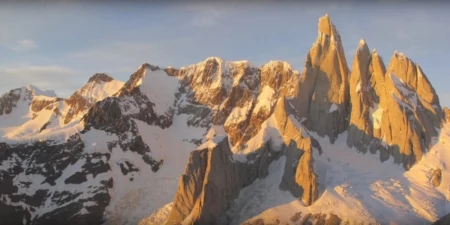On Cerro Torre: A Case Study in Human Behavior, Ideals and Actions
Perhaps an overly dramatic title. After all, it’s just climbing, and it’s supposed to be fun. That’s the cliché, anyway. Though often a disingenuous one.
Then again, part of what we love about climbing is the escape from the daily b.s. of today’s world, the immersion into a place where we can move freely in wild places and act however we wish.
Yes, act however we wish.
Since the 1974 first ascent of Cerro Torre, by Italy’s Ragni di Lecco team, only three new routes have been established to its summit without using the Compressor Route’s bolt ladders to get there.
I thought it would make for a cool story. (Cool side-note: Patagonia field testers and ambassadors were involved in all three of those ascents.) So I developed the idea and storyline, got audio and interviews from Rolando Garibotti, Colin Haley, and Hayden Kennedy, narrated the intro and transitions myself, recorded some field sounds, and selected and arranged the photos. We had audio and video gurus polish things up. The result, below, is a narrated slide show that rolls-through in video format.
Whenever you draw parameters, as I did in focusing on new routes to the summit that didn’t rely upon the bolt ladders to get there, of course questions arise. Why not include other ascents? Well, for one, I didn’t want the show to drag out. Indeed Cerro Torre has seen many tremendous efforts, like the first free ascent of the Southeast Ridge, by David Lama, last season. But I didn’t include it because it was a 2.5-pitch variation to Hayden Kennedy and Jason Kruk’s ascent – Hayden and Jason were the first to complete the Southeast Ridge by fair means, so they get first ascent credit. Granted, their line can reasonably be considered a culmination of efforts dating back to 1968, when an Anglo-Argentine team climbed halfway up the Southeast Ridge without placing a single bolt (Maestri and his compressor came along two years later), and spanning to the great Ermanno Salvaterra’s efforts with Mauro Mabboni in 1999, and Zach Smith and Josh Wharton’s attempt in 2007, and Kruk and Chris Geisler’s awesome near-miss in 2011. Likewise in my exclusions, I did not include the 1986 first free ascent of the Ragni di Lecco West Face route. Nor did I include some of the other tremendous efforts on Cerro Torre, like Devil’s Directissima and Quinique Anni ad Paradisum, both on the east face – phenomenal climbs that joined the Compressor Route up high, on the headwall.
Also, I intentionally avoided delving into the bolt removal controversy, though it’d seem remiss to ignore it completely. Rather, I chose to focus on these fair means ascents. Though that, too, raises questions, like what comprises “fair means”? Fair enough to consider.
As with many things in life, shades of gray surround many of the climbs on Cerro Torre and what we make of them. Cerro Torre has long been, and continues to be, a bizarre and fascinating theater of human behavior.
Where do we draw our lines?
Back to the front – “it’s supposed to be fun” or “it’s just climbing” can be used to justify anything. I remember once speaking with a climber who’d been caught misrepresenting their ascents to the media, and this person was trying to convince me that their lies didn’t matter, because, they told me, “Hey, it’s just climbing – it’s supposed to be fun.” An isolated example, sure, but I’m surprised at the frequency with which I hear those tired clichés used as excuses.
But of course there are more important things in the world than climbing.
And of course climbing’s supposed to be fun, and often it is (granted, with alpine climbing it’s usually Type II Fun – fun only in retrospect). But there’s a difference between waterslide fun and the “fun” one voluntarily endures when trying to climb a peak as vicious and beautiful as Cerro Torre, where you’re guaranteed to be cold, exhausted and scared, and where legendary winds and violent storms race uninterrupted off the ocean across the icecap and crash into the peak, sending ropes flying horizontally into the air and slamming-shut any illusions of climbing. No, we go to such places for reasons deeper than simple “fun.”
To borrow from Michael Kennedy in his powerful essay, “A Letter to My Son,” I think that devoted, committed climbing – as with anything in life that you love and dedicate yourself to – can illustrate “the distance between our ideals and what we are willing to sacrifice to live up to them.” It might even say something about who we are. Even if it’s just climbing, and even if it’s still fun.

